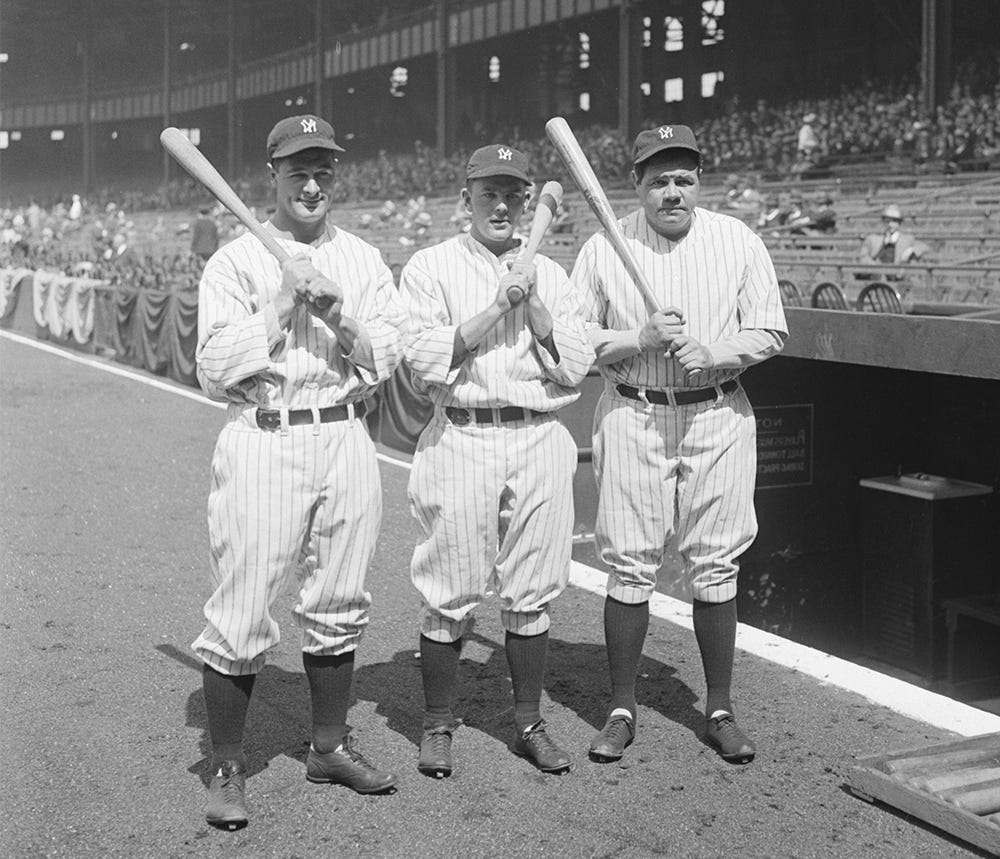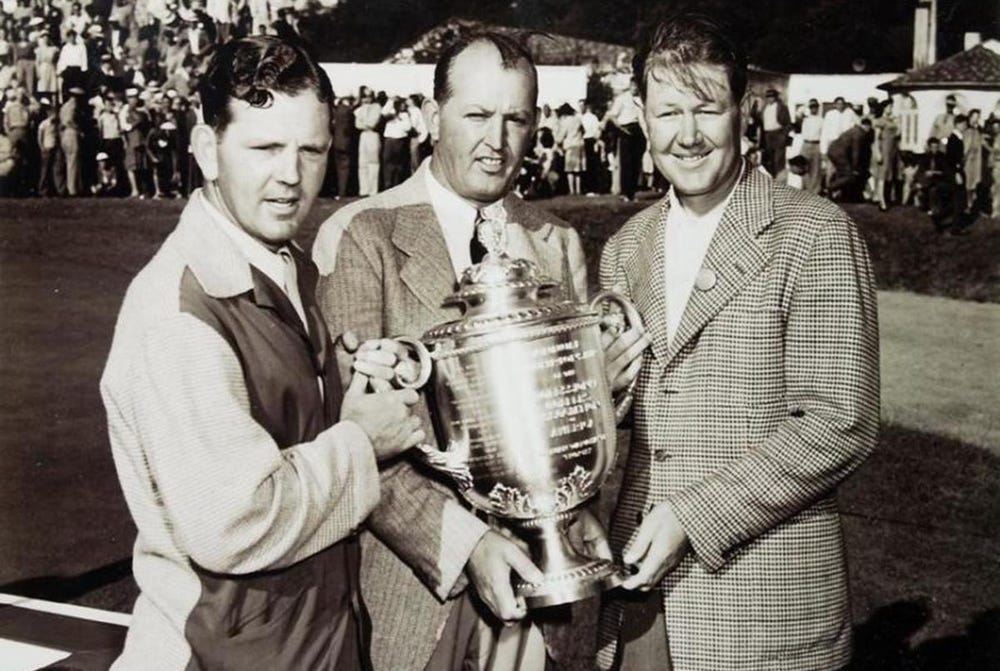Stray shots: Norman out? Byrd still in
LIV CEO's replacement bodes well for deal; two-sport star's teaching resonates
Sammy Byrd with Yankees mates Babe Ruth (right) and Lou Gehrig (left) (Getty archives)
By Peter Kaufman
1. Greg, we hardly knew ya? Stray Shots has long believed that no deal arrangement between PIF and the PGA Tour was feasible if Norman remained as head of LIV Golf. He is a lightning rod for decades of long-simmering ill-will between himself and the PGA Tour. He is divisive, and his approach has long felt to be the antithesis of “it’s nothing personal, it’s strictly business.”
Of course, Stray Shots has also long felt that replacing PGA Tour commissioner Jay Monahan is required to effect any mutual arrangement, but he has proven to be a cat with multiple lives.
That it’s now clear from multiple credible reports — including from Norman himself — that the Aussie will be exiting his post as CEO of LIV Golf certainly feels like a possible harbinger of real progress towards resolution that brings golf back together in some more harmonious fashion.
But sadly there are no guarantees of that. Rumors also abound that LIV is going to be picking off more PGA Tour stars, and, as well, that LIV might merge interests with the DP World Tour.
More to come, for a certainty.
Byrd (left) lost the 1946 PGA Championship to Byron Nelson (PGA of America)
2. Sammy Byrd and Jimmy Ballard. Today’s PGA Tour certainly lacks the characters from yesteryear … as well as villains. The former simply do not exist anymore, while all of the latter seem to be on LIV’s payroll these days — Patrick Reed, Brooks Koepka, Bryson DeChambeau, et al all play for the dark side at present.
As golf heads into the holidays before a new year, it’s a nice time to take a look back at interesting characters of the past, especially some whose impact is felt today.
Sam Byrd entered the ranks of touring golf professionals in the 1930s and was a prominent player through the 1940s. None other than Bobby Jones once proclaimed: “Byrd is the best man with a driver I ever saw.”
Byrd won six times on tour, finished third and fourth at the Masters, and was Byron Nelson’s victim in the finals of the 1945 PGA (it was match play) when Nelson won his fifth and final major.
So that’s Sam Byrd by the numbers: pretty nice player with a very credible tour record. Not easy to win on tour and he did it multiple times.
But there is a whole backstory behind those facts:
Byrd had previously enjoyed a seven-year career in Major League Baseball, five with the Yankees;
He was very friendly with Babe Ruth;
He often replaced Babe as a baserunner late in games when he had not started in the outfield;
Won a World Series in 1932 with the Yankees
The best man at his 1932 wedding was Yankee Hall of Fame catcher Bill Dickey
In 745 major-league games, Byrd posted a .274 batting average (465 hits in 1,700 at bats) with 304 runs scored, 38 home runs, 220 RBI, and a .412 slugging percentage. He recorded a .975 fielding percentage playing at all three outfield positions.
Here is where it gets really interesting: we can draw a direct line from Babe Ruth to Rocco Mediate and others yet today.
That’s because Sammy Byrd learned something critical from Babe Ruth about how to create power. Babe liked to practice with a handkerchief under his leading side armpit. He explained to Byrd his belief that keeping his lead upper arm welded to his chest was the secret to his titanic blasts — a.k.a. “staying connected.”
Sammy Byrd swinging at Yankee Stadium (George Rinhart/Corbis via Getty Images)
Byrd, who enjoyed a reputation as the best golfer in Major League Baseball (it’s unclear how many golfers were in the bigs, but in light of Byrd’s subsequent pro golf accomplishments, there could have been a slew of golfers in the majors and Byrd would still have been unchallenged) and he was a thoughtful student of the game.
As he considered Babe’s theory, Byrd experimented with the handkerchief under his leading armpit. And the rest is golf teaching history.
Byrd employed this approach in his tour career, and when he retired from the PGA Tour in 1949, he became a golf teaching pro (though he did shoot 3-under for 36 holes to win his age division at the PGA Seniors Teachers Trophy in Florida in 1967 for his last victory).
“A good record to quit with,” Byrd said at the time. “I was shaking on my putts in the last one, just like Hogan, and that’s something nobody escapes.”
In 1960 Byrd hired 17-year old Jimmy Ballard to assist at Byrd’s driving range/par 3 course in Alabama. Byrd taught young Ballard Babe’s connected thesis. And, in turn, Ballard became a famous golf teacher (and controversial, due to lack of universal golfing world embrace of connection) — maybe the first “celebrity” teaching pro.
Ballard went on to teach major champions such as Hal Sutton, Sandy Lyle and Curtis Strange as well as Rocco Mediate, who is still playing and winning on PGA Tour Champions. In his mid-80s now, Ballard still preaches his connection gospel to whomever will listen.
Byrd died in 1981 at age 74, one of the greatest two-sport athletes in history and the only one to compete in both the Masters and World Series.
Babe Ruth is still regarded by many as the greatest baseball player of them all. Being the progenitor of the connected golf swing was just a quiet sidebar in his incredible life and career. My grandfather reported when I was very young that he had played a round with Ruth, and that he “was great company, not a particularly good golfer but could hit the ball a country mile.” There was no report of a handkerchief being employed under his arm that day.





There was a Senior Tour in 1967??